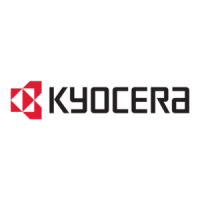In particular, avoid using paper with a surface coating or other surface treatment. The paper should have as smooth and even a surface as possible.
Composition Do not use paper that has been coated or surface-treated and contains plastic or carbon. The heat of fusing can cause such paper to give off
harmful fumes. Bond paper should contain at least 80% pulp.
Not more than 20% of the total paper content should consist of cotton or other fibers. Paper Size Cassettes and a MP tray are available for the paper sizes
listed in Table B.2. The dimensional tolerances are ±0.7 mm (±0.
0276 inches) for the length and width. The angle at the corners must be 90° ±0.2°. Table B.2 Paper Sizes for Paper Feeding Multi-Purpose tray Monarch
Business International DL International C5 International B5 Executive Commercial 9 Commercial 6-3/4 ISO A6 JIS B6 Hagaki Oufuku-Hagaki Size 3-7/8 ×
7-1/2 inches 4-1/8 × 9-1/2 inches 110 × 220 mm 162 × 229 mm 176 × 250 mm 7-1/4 × 10-1/2 inches 3-7/8 × 8-7/8 inches 3-5/8 × 6-1/2 inches 105 × 148
mm 128 × 182 mm 100 × 148 mm 148 × 200 mm Other sizes of paper can be fed manually. The minimum size of manually fed paper is 80 × 148 mm (3.1 ×
5.8 inches), fed lengthwise. The maximum size is 216 × 356 mm (8.5 × 14 inches).
Cassette or multi-purpose tray Legal Letter ISO A4 ISO A5 JIS B5 Custom Size 8.5 × 14 inches 8.5 × 11 inches 210 × 297 mm 148 × 210 mm 182 × 257 mm
148 × 210 mm to 216 × 356 mm B-2 B.2. Selecting the Right Paper Smoothness The paper should have a smooth, uncoated surface. Paper with a rough or
sandy surface can cause voids in the printed output. Paper that is too smooth, however, can cause multiple feeding and fogging problems. (Fogging is a gray
background effect.) Basis Weight Basis weight is the weight of a standard quantity of paper. In the traditional system the standard quantity is a ream
consisting of 500 sheets measuring 17 × 22 inches each.
In the metric system the standard quantity is 1 square meter. Paper that is too light or too heavy can cause misfeeding, jams, and premature wear of the
printer. Uneven paper weight can cause multiple feeds, print defects, poor toner fusing, blurring, and other print quality problems. The proper weight is 60 to
90 g/m² (16 to 24 lbs/ream). Thickness (Caliper) Thick paper is referred to as high-caliper paper and thin paper as low-caliper paper.
The paper used with the printer should be neither extremely thick nor extremely thin. If you are having problems with paper jams, multiple feeds, and faint
printing, the paper may be too thin. If you are having problems with paper jams and blurred printing the paper may be too thick. The proper thickness is
0.086 to 0.
110 mm (3.4 to 4.3 mils). Moisture Content Moisture content is defined as the percent ratio of moisture to the dry mass of the paper. Moisture can affect the
paper's appearance, feedability, curl, electrostatic properties, and toner fusing characteristics. The moisture content of the paper varies with the relative
humidity in the room. When the relative humidity is high and the paper absorbs moisture, the paper edges expand, becoming wavy in appearance. When the
relative humidity is low and the paper loses moisture, the edges shrink and tighten, and print contrast may suffer. Wavy or tight edges can cause misfeeding
and alignment anomalies. The moisture content of the paper should be 4% to 6%.
To ensure the proper moisture content it is important to store the paper in a controlled environment. Some tips on moisture control are: Ì Ì Ì Ì Ì Store paper in
a cool, dry location. Keep the paper in its wrapping as long as possible. Rewrap paper that is not in use. Store paper in its original carton. Place a pallet etc.
under the carton to separate it from the floor. After removing paper from storage, let it stand in the same room as the printer for 48 hours before use. Avoid
leaving paper where it is exposed to heat, sunlight, or damp. Paper Grain When paper is manufactured, it is cut into sheets with the grain running parallel to
the length (long grain) or parallel to the width (short grain).
You're reading an excerpt. Click here to read official KYOCERA
FS-1750 user guide
http://somemanuals.com/dref/324820

